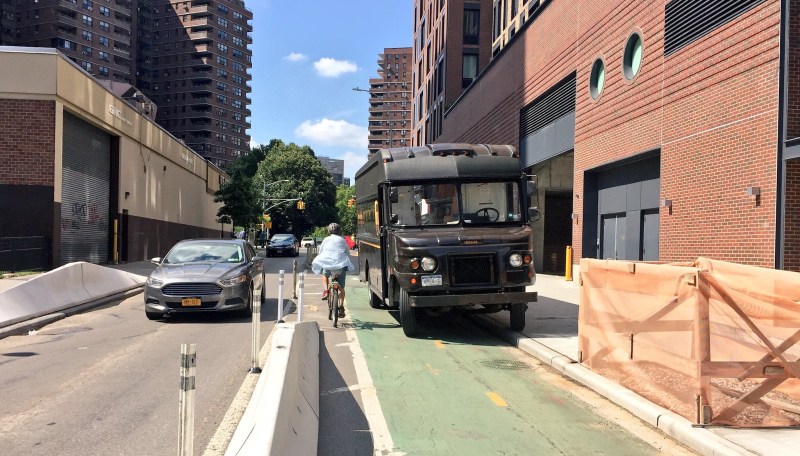Just Another Day in New York City’s Perpetually Blocked Bike Lanes
Until City Hall addresses the disconnect between the bike network people see on a map and the bike network people encounter in real life, stressful biking conditions will be the norm for New Yorkers.

To its credit, the de Blasio administration has continued to expand the city’s bike lane network, adding 25 new miles of protected bike lanes last year, with more underway in 2018.
Those bike lanes prevent traffic injuries and get more people on bikes. Nevertheless, once they go in, they’re more of a suggestion than a permanent, reliable right-of-way for bicycling. Even the protected lanes.
A quick scroll through the #bikenyc Twitter hashtag shows delivery trucks, construction vehicles, and NYPD cruisers blocking bike lanes across the city. The rampant illegal parking forces cyclists to maneuver into traffic, inflicting stress that DOT’s bike lane designs are supposed to prevent.
There are a few common varieties of bike lane blocker. One is the construction vehicle heedlessly parked to maximize the disruption of the bike network.
That’s the type you’re almost guaranteed to find on the two-way protected lane on Clinton Street south of Delancey. This is an important link in the bike network, connecting directly to the Williamsburg Bridge bike path. Parking in it is the bike network equivalent of parking on an FDR ramp. Because this is a two-way bike lane, the blockage is especially dangerous, forcing cyclists into oncoming traffic.
And it is constantly obstructed, as Jon Orcutt and Noel Hidalgo have documented for months:
"i don't mean to block the #bikenyc lane but i have no place else to park." – quote from the crew installing @Target's signage.
/cc @NYPD7Pct @nyc311 @NYC_DOT #VisionZero pic.twitter.com/n0cyJaX0fL
— noel hidalgo • ?????? (@noneck) July 30, 2018
DOT did recently add a concrete barrier to a section of the bike lane between Grand Street and Delancey Street. But the photo at the top of this post shows that it’s not enough to deter drivers from parking in the bike lane.
Delivery vehicles like that UPS truck are also ubiquitous bike lane blockers. For them, parking tickets are just another cost of doing business, with the city’s stipulated fine program weakening the incentive to avoid blocking bike lanes. Until there are enough loading zones to accommodate all these deliveries, there’s no end in sight to the disruptions of the bike network.
After DOT installs bike lanes, the responsibility to keep them clear falls to NYPD. But police do nothing, and Mayor de Blasio has essentially said that’s fine.
NYPD is, after all, the single biggest institutional bike lane blocker. Further north in Manhattan yesterday, police officers were parked in the 29th Street protected lane. While this is a brand new bike lane and some adjustment period is to be expected, the markings are down and if police actually cared about maintaining a safe bike network they would be setting a better example.
https://twitter.com/CatlinMichael/status/1024310318678376449
These obstructions are preventable, but there’s no inter-agency strategy to make that happen. Nor does DOT use the levers at its disposal. The agency can get tough on contractors that impede bike traffic but fails to do so, Orcutt notes, and its resurfacing crews similarly lack guidelines for maintaining bike lanes when streets are being repaved.
Until City Hall addresses the disconnect between the bike network people see on a map and the bike network people encounter in real life, stressful biking conditions will be the norm for New Yorkers.
https://twitter.com/jason_a_koch/status/1024383109297577985
